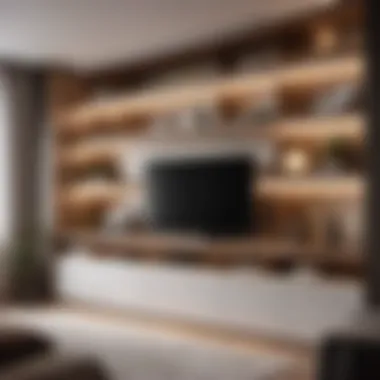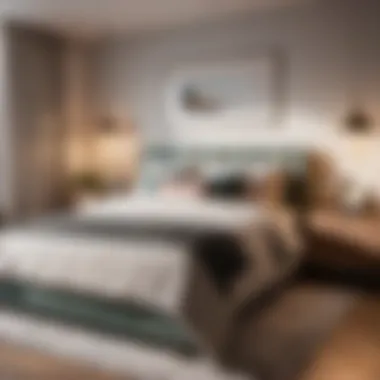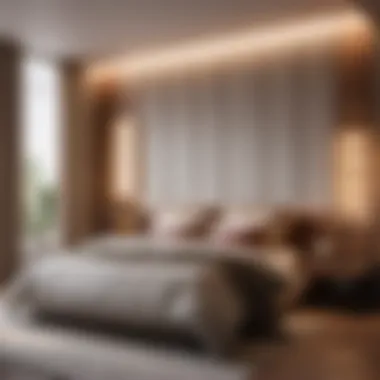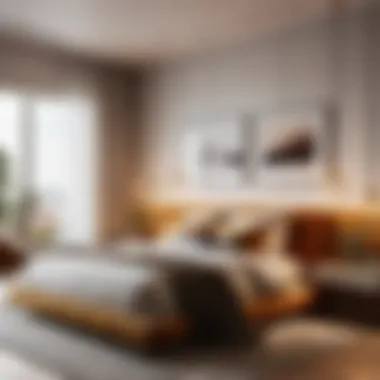Unlocking the Art of Perfect Bedroom Unit Layouts for Maximum Functionality


Materials:
- Measuring tape
- Pencil
- Paper
- Furniture catalog (optional)
- Computer or tablet for research
- Graph paper or room design software
- Budget planner
DIY Steps:
- Start by measuring the dimensions of your bedroom space accurately. Note down the width, length, and height of the room.
- Sketch a rough layout on paper, indicating the placement of windows, doors, and any built-in features like closets or alcoves.
- Research different furniture options that suit the dimensions of your room and fit your functional needs. Take note of the measurements of potential furniture pieces.
- Use graph paper or a room design software to create a scaled model of your bedroom layout, placing furniture according to your rough sketch and taking into consideration traffic flow and ease of movement.
- Plan your budget for furniture purchases, considering quality and functionality.
Technical Aspects:
- Tools: Measuring tape, pencil, computer or tablet, graph paper or room design software
- Timing specifics: Allow ample time for planning and researching before making any purchases
- Critical techniques: Utilize online room design tools for more precise layouts, focus on maximizing storage space without overcrowding the room
DIY Project Process:
- Begin by clearing out the existing furniture from the room and thoroughly cleaning the space.
- Start with placing essential furniture pieces like the bed and wardrobe in their designated spots, ensuring they align with the planned layout.
- Assemble any furniture that requires it, following the manufacturer's instructions carefully to avoid any mistakes.
- Add decorative elements like rugs, curtains, and wall art to enhance the aesthetics of the room.
Troubleshooting Tips:
- If furniture doesn't fit as expected, reconsider the layout and potentially return or exchange items that are too large.
- In case of budget constraints, consider DIY solutions like repurposing existing furniture or exploring thrift stores for affordable options.
Understanding Bedroom Units


Understanding Bedroom Units is a crucial aspect when it comes to creating a functional and aesthetically pleasing bedroom space. This section aims to delve into the core elements that define bedroom units and why they play a vital role in optimizing the layout of a bedroom. By understanding bedroom units, individuals can harness the potential to transform their personal sanctuary into a harmonious and efficient living environment.
Importance of Bedroom Layouts
Enhancing Sleep Quality
Enhancing Sleep Quality is not just about having a comfortable bed; it encompasses a holistic approach to promoting better sleep patterns and overall well-being. Effective bedroom layouts can contribute significantly to improving sleep quality by considering factors such as mattress firmness, bedding materials, and room temperature regulation. By prioritizing Enhancing Sleep Quality in bedroom layouts, individuals can create a conducive environment for rest and relaxation, ultimately boosting their health and productivity.
Stress Reduction
Stress Reduction is a key benefit of optimizing bedroom layouts. By incorporating elements that promote relaxation and serenity, such as calming colors, clutter-free spaces, and natural textures, individuals can design a bedroom that acts as a retreat from the challenges of daily life. Stress Reduction in bedroom layouts enables individuals to unwind, recharge, and find solace in their personal haven, fostering mental and emotional well-being.
Reflecting Personal Style
Reflecting Personal Style adds a unique touch to bedroom layouts, allowing individuals to express their personality and preferences through design choices. Whether opting for minimalist decor, vibrant accents, or eclectic furnishings, incorporating Personal Style into bedroom layouts creates a space that feels truly personalized and inviting. By reflecting Personal Style in bedroom design, individuals can cultivate a sense of ownership and comfort within their living environment.
Factors Influencing Layout Decisions
Room Size
Room Size plays a pivotal role in determining the layout and functionality of a bedroom. Small spaces may require creative storage solutions and space-saving furniture to maximize utility, while larger rooms offer more flexibility in layout design. Understanding how Room Size influences layout decisions enables individuals to make informed choices that balance comfort, aesthetics, and practicality within their bedroom space.
Natural Light
Natural Light can transform the ambiance of a bedroom, enhancing mood and energy levels. Integrating natural light sources through windows, skylights, or light wells can illuminate the space, create visual interest, and establish a connection with the outdoors. Considering the effects of Natural Light on bedroom layouts allows individuals to harness its benefits for a brighter, more uplifting living environment.
User Preferences
User Preferences encompass individual habits, tastes, and lifestyle needs that shape bedroom design choices. Whether prioritizing functionality, privacy, or decor themes, understanding User Preferences is essential for tailoring the bedroom layout to meet specific requirements. By aligning layout decisions with User Preferences, individuals can create a bedroom space that not only looks visually appealing but also aligns with their practical and aesthetic sensibilities.
Storage Solutions
In the intricate world of optimizing functional bedroom unit layouts, storage solutions emerge as a pivotal element that can significantly enhance the overall functionality and aesthetics of a bedroom space. Understanding the importance of efficient storage is crucial in maintaining a clutter-free environment and maximizing the use of space in a bedroom setting. By strategically incorporating storage solutions, housewives and homeowners can achieve a well-organized and visually appealing bedroom that promotes relaxation and a sense of harmony.
Closet Organization


Built-in Wardrobes
Built-in wardrobes play a vital role in the realm of storage solutions within bedroom layouts. These customized wardrobe units are tailored to fit the specific dimensions of a space, offering ample storage capacity while seamlessly blending with the room's decor. The key characteristic of built-in wardrobes lies in their ability to optimize space utilization by providing designated compartments for hanging clothes, shelves for folded items, and drawers for accessories. Their popularity stems from the seamless and integrated look they lend to a bedroom, making them a preferred choice for those seeking a sleek and organized storage solution. One of the distinct advantages of built-in wardrobes is their versatility in accommodating various storage needs while maintaining a streamlined appearance, contributing to the overall functionality and aesthetic appeal of bedroom units.
Drawer Dividers
Drawer dividers serve as essential components of closet organization by compartmentalizing and maximizing drawer space efficiently. The distinctive characteristic of drawer dividers lies in their ability to categorize and separate different items within a single drawer, facilitating orderly storage and easy access to belongings. They are a popular choice for enhancing organization by keeping items neatly arranged and preventing clutter. Drawer dividers offer the benefit of customizable storage solutions, allowing users to adjust compartment sizes based on their specific needs. While promoting tidiness and accessibility, drawer dividers contribute to streamlined and efficient closet organization within the context of optimizing functional bedroom unit layouts.
Shelving Systems
Shelving systems present an innovative approach to storage solutions in bedroom layouts, offering versatile options for displaying and organizing various items. The key characteristic of shelving systems lies in their capacity to utilize vertical wall space effectively, providing storage opportunities for books, decor, clothing, or personal belongings. Their popularity stems from the ability to enhance the visual appeal of a room while serving practical storage functions. Shelving systems offer a unique feature of customizable configurations, allowing homeowners to create personalized displays and storage solutions that align with their aesthetic preferences and storage needs. Although shelving systems enhance the decorative aspect of a bedroom, they also provide practical advantages by optimizing storage capacity and maximizing space utilization within the overarching goal of creating harmonious and efficient bedroom layouts.
Furniture Placement
When it comes to optimizing functional bedroom unit layouts, furniture placement plays a pivotal role in balancing both functionality and aesthetics within a space. The strategic arrangement of furniture not only impacts the visual appeal of the room but also influences how the space is utilized on a daily basis. By carefully considering specific elements such as bed positioning, wall space utilization, and overall flow, homeowners can create a bedroom layout that is both efficient and visually appealing.
Bed Positioning
In the realm of furniture placement within a bedroom, bed positioning stands out as a key element that sets the tone for the entire space. Whether centered or off-center, the placement of the bed can significantly impact the room's overall feel and functionality.
Centered vs. Off-Center
When choosing between a centered or off-center bed positioning, homeowners must consider the symmetry and balance within the room. A centered bed often creates a more traditional and symmetrical look, offering a sense of harmony and order. On the other hand, opting for an off-center placement can introduce a unique and dynamic element to the space, adding personality and visual interest.
Facing the Door
The orientation of the bed in relation to the bedroom door is another crucial aspect to contemplate. Placing the bed facing the door not only maximizes the visual appeal of the room but also enhances functionality by allowing easier access and a clear line of sight from the entrance.
Away from Windows
While natural light is desirable, positioning the bed away from windows is often preferred to avoid direct exposure to drafts or excessive sunlight. This arrangement enhances comfort and ensures that the placement of the bed does not disrupt the overall flow of the room.
Optimizing Wall Space
Aside from bed positioning, optimizing wall space is essential for maximizing storage and enhancing the visual appeal of the bedroom. From floating shelves to wall-mounted desks and vertical storage units, these elements offer innovative solutions to make the most of vertical space.


Floating Shelves
Floating shelves not only provide additional storage options but also create a stylish display area for decorative items or books. Their minimalistic design adds a modern touch to the room while maximizing storage capacity.
Wall-Mounted Desks
Ideal for compact spaces, wall-mounted desks are practical solutions for creating a functional workspace without occupying valuable floor space. Their versatility and ergonomic design make them a popular choice for homeowners looking to blend work and relaxation seamlessly.
Vertical Storage Units
Vertical storage units are excellent for utilizing vertical space efficiently while keeping the floor area uncluttered. Their multi-tiered design allows for categorizing and organizing belongings effectively, making them ideal for optimizing storage within limited square footage.
Design Elements
When delving into the optimization of functional bedroom unit layouts, one crucial aspect that significantly impacts the overall ambiance and functionality is the consideration of design elements. Design elements encompass various components such as color palette and lighting fixtures, which play a pivotal role in shaping the atmosphere of a bedroom. By meticulously selecting and incorporating these elements, one can create a space that not only looks visually appealing but also enhances the overall comfort and utility within the room.
Color Palette
Soothing Neutrals
Soothing neutrals hold immense importance in the context of bedroom design as they offer a sense of tranquility and relaxation to occupants. The key characteristic of soothing neutrals lies in their ability to create a calming atmosphere that promotes rest and rejuvenation. In this article, opting for a soothing neutral color palette can be a beneficial choice as it contributes to a serene environment conducive to quality sleep. The unique feature of soothing neutrals is their versatility in complementing various design styles and furniture choices. However, a potential disadvantage is the risk of appearing too bland if not appropriately balanced with texture and accent hues.
Bold Accents
On the other hand, bold accents inject personality and vibrancy into bedroom spaces. Bold accent colors serve to add visual interest and create focal points within the room. Choosing bold accents can be advantageous in adding a touch of drama and uniqueness to the design scheme discussed in this article. The key characteristic of bold accents is their ability to introduce energy and excitement into an otherwise serene space. However, a challenge with bold accents is striking the right balance to prevent overwhelming the room with intense colors.
Monochromatic Schemes
Monochromatic schemes involve utilizing variations of a single color throughout the bedroom design. In the context of this article, monochromatic schemes offer a sophisticated and cohesive look to the space. The key characteristic of monochromatic schemes is their ability to create a sense of harmony and unity within the room. Opting for a monochromatic color palette in this article can be a beneficial choice as it provides a timeless and elegant aesthetic. The unique feature of monochromatic schemes is their versatility in allowing for subtle variations in shade and tone to add depth to the room. However, a potential disadvantage is the risk of monotony if not complemented with texture and pattern to create visual interest.
Lighting Fixtures
Bedside Lamps
Bedside lamps play a vital role in the functionality and ambiance of a bedroom. The strategic placement of bedside lamps contributes to creating a cozy reading nook or providing soft illumination for winding down at night. In this article, bedside lamps are a beneficial choice as they offer adjustable lighting levels for different activities like reading or relaxing. The unique feature of bedside lamps is their diverse range of styles and designs to complement various interior motifs. However, a possible disadvantage is the need for adequate table space to accommodate the lamps without cluttering the bedside area.
Overhead Lighting
Overhead lighting serves as the primary source of illumination in a bedroom and sets the overall tone for the space. The key characteristic of overhead lighting is its ability to provide ambient lighting that brightens the entire room evenly. In the context of this article, overhead lighting is a popular choice for its functionality and ability to disperse light effectively. The unique feature of overhead lighting is its ability to offer general illumination while allowing for additional accent lighting options. However, a disadvantage of overhead lighting is the potential for a harsh or stark lighting effect if not supplemented with softer lighting sources.
Dimmer Switches
Dimmer switches offer unparalleled flexibility in adjusting the intensity of lighting in a bedroom. The convenience of dimmer switches lies in their ability to transition the room's lighting from bright and functional to soft and ambient with a simple adjustment. In this article, dimmer switches are a beneficial choice as they enable users to customize the lighting levels according to their needs and mood. The unique feature of dimmer switches is their energy-saving capabilities by allowing users to dim lights when less illumination is required. However, a potential disadvantage is the initial investment cost associated with installing dimmer switch systems.







